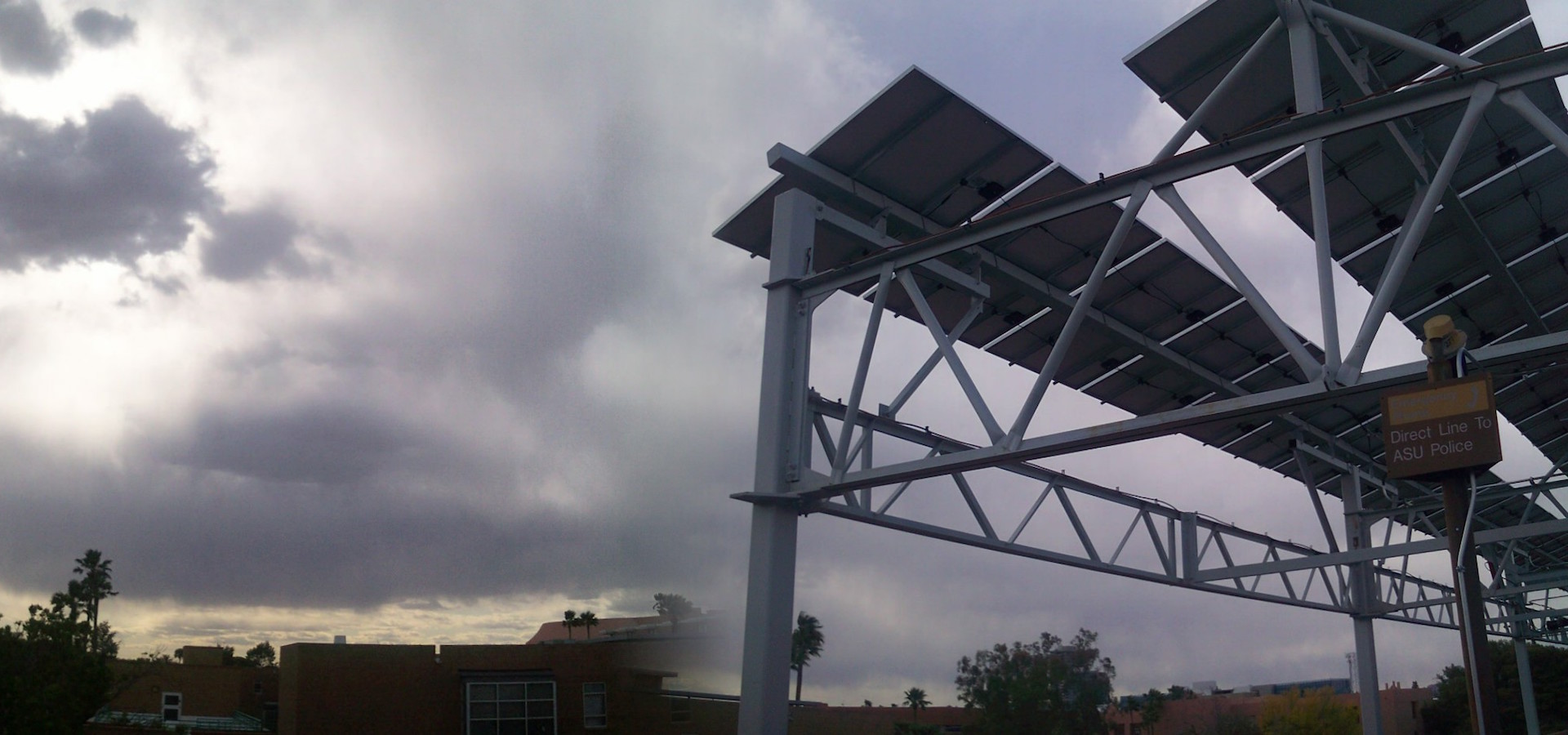Just like every other form of power, renewable energy can be vulnerable to natural disasters (although considering the alternatives, the fallout is less dangerous). But as climate change makes storms more violent, it’s worth considering how to insure new renewable plants. Emilio Godoy takes a look at how Latin American countries are handling it.

Weathering the storm: climate-change related disasters pose a threat to renewable energies, too (Photo by Kevin Dooley, edited, CC BY 2.0)
In September 2014, the Odile hurricane devastated the Aura Solar photovoltaic plant, located in the city of La Paz in the north-western state of Baja California Sur.
Designed to be the largest solar plant in Latin America, with an 82 GWh/year generation capacity, the installation was inoperative for several months due to the damage caused by the hurricane. Neither the plant operator Aura Solar nor its sole client the state-owned Federal Electricity Commission admitted to any climate risks related to the installation.
The $US100 million project was planned to provide electricity to 160.000 inhabitants in La Paz, about 64% of the city population. To cover the population during the emergency, the city had to rely on energy from gas and thermoelectric plants nearby.
The Aura Solar case shows how renewable energy projects sometimes face climate risks. It is thus necessary to acknowledge them, just as the oil and gas industry was recently forced to acknowledge their climate risks and impacts. Renewable installations too may be exposed to the consequences of climate change – more and more cyclones, flooding or earthquakes.
However, in the renewable industry, private and multilateral banks, hedge funds and other financial stakeholders involved in the sector have not yet had to disclose those kinds of risks. Better transparency could improve location, planning, insurance, and emergency response. The possibility of renewable installations becoming stranded assets due to climate situations (as is happening to fossil fuel investments) is unlikely, but all stakeholders need to know the level of threat to the projects.
It is well-known that there are geopolitical, legal, financial, physical and humans rights risks associated with renewable energy installations, too. Moreover, the solar and wind industries leave an ecological footprint in the production of panels and batteries.
The environmental risk refers to any damage to the environment caused by the power plant, and the liability arising from such damage. Operational risk alludes to unplanned plant closure, for example owing to unavailability of resources, plant damage or component failure (like Aura Solar).
Mexico has already organised two electricity auctions in March of this year, with 18 projects winners. Last September, 53 ventures and a total capacity of 8,771 MW were awarded project bids. Currently, the government is developing a third round of renewable energy auctions, yet the companies still do not have to disclose anything regarding their associated climate risks despite there already being some guidelines in place.
Last December, the Task Force on Climate-related Financial Disclosures (TCFD) announced a set of recommendations on climate risks transparency. The group suggested measures on governance, strategy, risk management and metrics and targets, useful for every type of company, including those in the renewable sector.
In terms of strategy, the TCFD analysed the actual and potential impacts of climate-related risks and opportunities on the organization’s businesses, strategy, and financial planning. The Financial Stability Board (FSB), established after the G20 summit in London in 2009, is an international body that monitors and makes recommendations on the global financial system. It is expected that the TCFD will issue its final report in June, prior to the July G20 meetings in Hamburg.
Latin America and the Caribbean generate more than 200 GW from renewable sources, representing 11% of the global generating capacity. The region has attracted at least US$500 million in renewable investments, directed principally at Brazil, Chile, Uruguay and Mexico. These investment also lack climate risks assessment.
Builders, operators and financers can reveal the level of climate exposition of their projects based on an analysis of the tendencies of hurricanes or flooding that have historically hit the zones chosen to install the plants. So, all the stakeholders can improve their contribution to the planning and operation of the plants. For the insurance industry, it could be a way of extending their coverage of climate disasters, an already blossoming sector.
Institutions such as the Inter-American Development Bank, the International Finance Corporation (the World Bank’s private finance branch), the Andean Development Corporation, the United States Export-Import Bank, and the Brazilian Development Bank could benefit from taking into account these risks. They all have helped private project developers implement significant renewable energy and energy efficiency infrastructure in developing countries and throughout Latin America.
In conclusion, renewables need a movement for risk disclosure to have more transparent and accountable investment schemes (just as fossil fuels did in the past). I am not arguing that renewable energy projects are intrinsically bad, just that they need to be subject to the same “rules” of the fossil energy sector. Only when risk assessments are done holistically for renewable energy projects can we argue that they are “better” on all counts.
As always, compared to what? The seismic risks to nuclear plants are horrendous, as Fukushima showed. Fossil fuel plants and their supply chains are reasonably robust against a variety of risks, but not foolproof. A wind turbine is a strong structure, as shown by the way pilot offshore wind turbines survived the Fukushima tsunami. They routinely ride through storm-force winds. Solar farms are much flimsier, though they should be fairly easy to repair. Hydro dams are built to very high margins of safety.